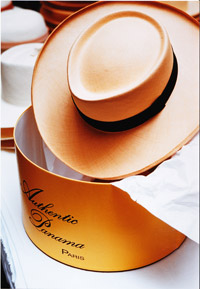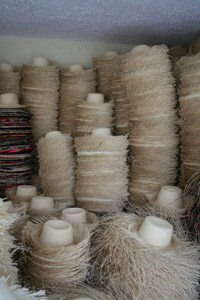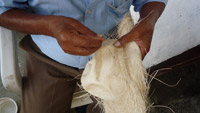TO MEASURE
History
 Artisans in Ecuador began making straw hats in the 17th century. In the 18th century, the hats, called "Jipijapa" (after the name of the small town they originated in) or "Montecristi" (where the finest weavers were) had their first boom, yet the legend of the "sombrero de paja toquilla" did not really take off until it became known as the "Panama" hat…
Artisans in Ecuador began making straw hats in the 17th century. In the 18th century, the hats, called "Jipijapa" (after the name of the small town they originated in) or "Montecristi" (where the finest weavers were) had their first boom, yet the legend of the "sombrero de paja toquilla" did not really take off until it became known as the "Panama" hat…
The grand era of the Panama hat paralleled the development of the cocoa bean trade as the hats were worn on all the plantations. Hat production was already relatively well established when in 1835, an ambitious Spaniard made his fortune by exporting the famous hats to the Gulf of Panama where he opened a trading post, to sell to those who were on their way to California for the gold rush.
 From then on, the elegant hats were widely exported to the United States (220,000 in 1839), and booming sales prompted the town of Cuenca (further inland) to begin producing affordable hats which were accessible to those with more modest means.
From then on, the elegant hats were widely exported to the United States (220,000 in 1839), and booming sales prompted the town of Cuenca (further inland) to begin producing affordable hats which were accessible to those with more modest means.
Europe had to wait until 1855 when the hat was introduced at the World Fair in Paris, during which a "fino" offered to Napoleon III started the fashion in the French capital.
And so the hat was called a "Panama", after where it was first shipped from rather than the country in which it originated. The luxury hat quickly became a favourite travel accessory among the high society. From then on, the hat's reputation spread throughout the world.
The making of
 The making of a Panama hat begins with the selection of the "paja toquilla", the straw used for hat making, which comes from the Carludovica palmata palm-like plant whose leaves are fan shaped. The young shoots or "cogollos" that are used measure one metre in length and one centimetre in diameter. The person who cuts them is called a "pajero". Once the leaves are cut, they are tied together in bundles and transported to the village. There, the shoots are slit down the middle with a knife to separate the tender young leaves from the fibrous matter. Then come the various steps of washing, drying and bleaching the straw after which the final selection takes place and depends on suppleness, size, light colour and fineness. The finer the fibre, the longer it takes to weave, resulting in a more exclusive Panama hat…
The making of a Panama hat begins with the selection of the "paja toquilla", the straw used for hat making, which comes from the Carludovica palmata palm-like plant whose leaves are fan shaped. The young shoots or "cogollos" that are used measure one metre in length and one centimetre in diameter. The person who cuts them is called a "pajero". Once the leaves are cut, they are tied together in bundles and transported to the village. There, the shoots are slit down the middle with a knife to separate the tender young leaves from the fibrous matter. Then come the various steps of washing, drying and bleaching the straw after which the final selection takes place and depends on suppleness, size, light colour and fineness. The finer the fibre, the longer it takes to weave, resulting in a more exclusive Panama hat…
Fabrication
 The weaver chooses the straw according to the type of hat he wants to make (fino, superfino, etc.). He begins by the "rosette" (the centre of the top of the hat) with eight criss-crossed fibres, then, as he weaves, he adds new straw until he has created a crown of the desired size. This first step requires a great deal of technical skill and manual dexterity.
The weaver chooses the straw according to the type of hat he wants to make (fino, superfino, etc.). He begins by the "rosette" (the centre of the top of the hat) with eight criss-crossed fibres, then, as he weaves, he adds new straw until he has created a crown of the desired size. This first step requires a great deal of technical skill and manual dexterity.
The crown is then placed on a hat block, which itself is set on a three-footed stand. The weaver works standing up and weaves with three fingers which he dips frequently into water to keep the straw moist. Once the crown is complete, he weaves the brim before passing it on to a finisher who weaves the protruding straw ends back inside the hat creating a perfect finishing of the edges known as "rematé".
At this stage of production, the Panama hat must still be shaped by a qualified hat maker who traditionally moulds the crown on a wooden hat block using steam and a mallet. The brim is then ironed or starched. The finishing touches consist of applying an inner band that maintains the hat's oval shape, and finally by choosing a decorative band.
La Chapelière sources its crowns from the most exclusive artisans in Ecuador in accordance with uncompromising criteria: the fineness and regularity of the weave as well as the perfection of the brim. We are therefore able to offer you Panama hats of a quality that is rare, even in Ecuador!
 Artisans in Ecuador began making straw hats in the 17th century. In the 18th century, the hats, called "Jipijapa" (after the name of the small town they originated in) or "Montecristi" (where the finest weavers were) had their first boom, yet the legend of the "sombrero de paja toquilla" did not really take off until it became known as the "Panama" hat…
Artisans in Ecuador began making straw hats in the 17th century. In the 18th century, the hats, called "Jipijapa" (after the name of the small town they originated in) or "Montecristi" (where the finest weavers were) had their first boom, yet the legend of the "sombrero de paja toquilla" did not really take off until it became known as the "Panama" hat… From then on, the elegant hats were widely exported to the United States (220,000 in 1839), and booming sales prompted the town of Cuenca (further inland) to begin producing affordable hats which were accessible to those with more modest means.
From then on, the elegant hats were widely exported to the United States (220,000 in 1839), and booming sales prompted the town of Cuenca (further inland) to begin producing affordable hats which were accessible to those with more modest means. The making of a Panama hat begins with the selection of the "paja toquilla", the straw used for hat making, which comes from the Carludovica palmata palm-like plant whose leaves are fan shaped. The young shoots or "cogollos" that are used measure one metre in length and one centimetre in diameter. The person who cuts them is called a "pajero". Once the leaves are cut, they are tied together in bundles and transported to the village. There, the shoots are slit down the middle with a knife to separate the tender young leaves from the fibrous matter. Then come the various steps of washing, drying and bleaching the straw after which the final selection takes place and depends on suppleness, size, light colour and fineness. The finer the fibre, the longer it takes to weave, resulting in a more exclusive Panama hat…
The making of a Panama hat begins with the selection of the "paja toquilla", the straw used for hat making, which comes from the Carludovica palmata palm-like plant whose leaves are fan shaped. The young shoots or "cogollos" that are used measure one metre in length and one centimetre in diameter. The person who cuts them is called a "pajero". Once the leaves are cut, they are tied together in bundles and transported to the village. There, the shoots are slit down the middle with a knife to separate the tender young leaves from the fibrous matter. Then come the various steps of washing, drying and bleaching the straw after which the final selection takes place and depends on suppleness, size, light colour and fineness. The finer the fibre, the longer it takes to weave, resulting in a more exclusive Panama hat… The weaver chooses the straw according to the type of hat he wants to make (fino, superfino, etc.). He begins by the "rosette" (the centre of the top of the hat) with eight criss-crossed fibres, then, as he weaves, he adds new straw until he has created a crown of the desired size. This first step requires a great deal of technical skill and manual dexterity.
The weaver chooses the straw according to the type of hat he wants to make (fino, superfino, etc.). He begins by the "rosette" (the centre of the top of the hat) with eight criss-crossed fibres, then, as he weaves, he adds new straw until he has created a crown of the desired size. This first step requires a great deal of technical skill and manual dexterity.